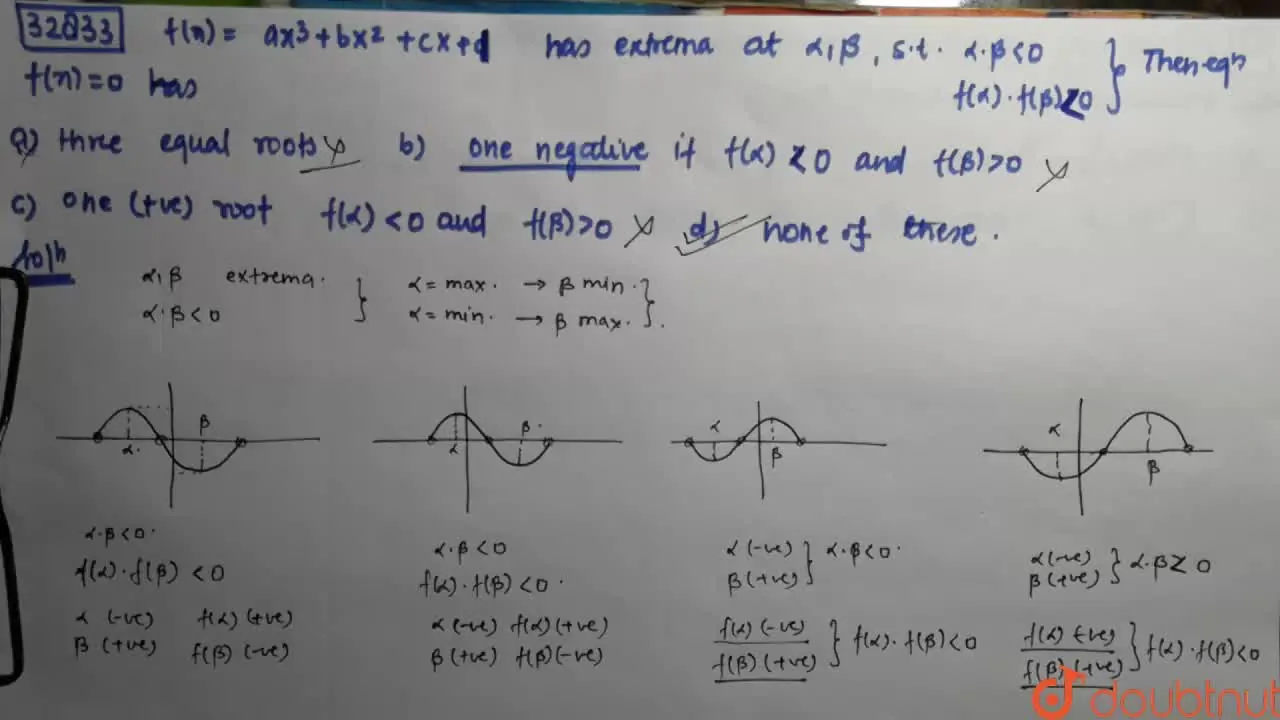Let f(x)=ax3+bx2+cx+1 has exterma at x=α,β such that αβ<0andf(α)f(β)<0 . Then the equation f(x)=0 has three equal real roots one negative root if f(α)⟨0andf(β)⟩0 one positive root if f(α)⟨0andf(β)⟩0 none of these
three distinct real roots
one positive root if f(α)<0andf(β)>0
on negative root if f(α)>0 and (β)<0
all the above
The correct Answer is:D
We have ,
αβ<0
⇒αandβ are of opposite signs
Let α<0andβ>0
If is given that f(x) has extrema at x=α,β Therefore αandβ are two distinct real roots of f' (x)=0 .But we know that between two distinct roots a polynominal there is at least one real root of its derivative. Therefore,f(x) has three distinct real roots γ,μ and v (say) such that
γ<α<μ<β<v

Thus,option (a)is correct.
If f(x)=0 has exactly one positive root, then it is evident from Fig .23 that v>0andγ,μ<0

Therefore
α<μ<0
⇒f(α)f(0)<0 [∵μ lies between alpha and 0]
⇒f(α)<0 [∵f(0)=1<0]
⇒(α)>0 [∵f(α)f(β)<0] ltbtgt Thus option (b) is correct
If f(x) =0 has exactly one negative real root , then from Fig , 24 we have

γ<0andμv>0
⇒0<μ<β
Related Playlists
- BOOK - OBJECTIVE RD SHARMACHAPTER - MAXIMA AND MINIMA EXERCISE - Section II - Assertion Reason Type7videos
MAXIMA AND MINIMA
- BOOK - OBJECTIVE RD SHARMACHAPTER - MAXIMA AND MINIMA EXERCISE - Exercise50videos
MAXIMA AND MINIMA
- BOOK - OBJECTIVE RD SHARMACHAPTER - MAXIMA AND MINIMA EXERCISE - Chapter Test30videos
MAXIMA AND MINIMA
- BOOK - OBJECTIVE RD SHARMACHAPTER - MATHEMATICAL REASONING EXERCISE - Chapter Test20videos
MATHEMATICAL REASONING
- BOOK - OBJECTIVE RD SHARMACHAPTER - MEASURES OF CENTRAL TENDENCYEXERCISE - Chapter Test21videos
MEASURES OF CENTRAL TENDENCY
Similar Questions
Let f(x)=ax3+bx2+cx+1 has exterma at x=α,β such that αβ<0andf(α)f(β)<0 f . Then the equation f(x)=0 has three equal real roots one negative root if f(α) (a) 0andf(β) (b) one positive root if f(α) (c) 0andf(β) (d) none of these
View SolutionLet f(x)=ax3+bx2+x+d has local extrema at x=αandβ such that αβ<0andf(α).f(β)>0. Then the equation f(x)=0 (A) has 3 distinct real roots (B) has only one real which is positive o a.f(α)<0 (C) has only one real root, which is negative a.f(β)>0 (D) has 3 equal roots
View SolutionLet f(x)=x3+2x2+x+5. Show that f(x)=0 has only one real root α such that [α]=−3
View SolutionLet equation x2+bx+c=0 has roots α and β such that α+β=3αβ Also α+5 and β+5 are roots of the equation x2+ex+f=0 such that ef=123, then the value of (b+c) is equal to
View SolutionLet f(x)=(x2−5x+4)(x2+5x+4)andα,β,γ (where α<β<γ) are roots of f'(x)=0, then the value of [α]2+[β+1][γ] is equal to (where [.] denote greatest integer function)
View SolutionIf the equation 3x2−2x−3=0has roots α, and β then α.β=______.
View SolutionLet g(x)=cosx2,f(x)=√x and α,β(α<β) be the roots of equation
View SolutionLet f(x)=ax2+bx+c=0 be a quadratic equation and α,β are its roots if c≠0 then αβ≠0 and f(1x)=0 is an equation whose roots are
View SolutionLet f(x)=ax2+bx+c=0 be a quadratic equation and α,β are its roots if c≠0 then α,β≠0 and f(1x)=0 is an equation whose , roots are
View SolutionLet α,andβ are the roots of the equation x2+x+1=0 then
View Solution


